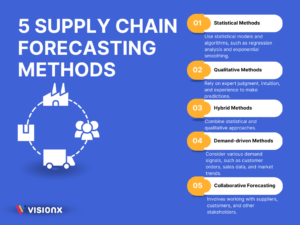Forecasting in supply chain is a crucial aspect of supply chain management. It involves predicting the demand for products and services and anticipating the available resources and materials needed to meet that demand. This helps organizations make informed decisions, minimize waste and inefficiencies, and ensure that customers receive the products and services they need promptly and cost-effectively.
In this blog, we will explore different forecasting supply chain methods, discuss the future of forecasting, and make some key recommendations for businesses to stay ahead of the competition and meet the demands of the modern marketplace.
Importance of Supply Chain Forecasting
Forecasting is critical for organizations to maintain a competitive edge in today’s fast-paced business environment. It enables them to respond quickly and effectively to market conditions, customer demand, and other variables impacting their operations.
“Gartner, Inc. predicts that by 2025, 70% of organizations will shift their focus from big to small and wide data, providing more context for analytics and making artificial intelligence (AI) less data hungry.”
By accurately predicting demand and resource needs, supply chain forecasting helps organizations to:
- Minimize stockouts and overstocking
- Improve customer satisfaction by ensuring product availability
- Optimize production and delivery schedules
- Reduce waste and costs associated with inefficient operations
Supply Chain Forecasting Methods

Supply chain forecasting methods are various techniques used to predict future demand for products and services and anticipate the available resources and materials needed to meet that demand. Some of the commonly used forecasting supply chain methods include:
- Statistical methods use statistical models and algorithms, such as regression analysis, time series analysis, and exponential smoothing, to forecast demand based on historical data and other relevant information.
- Qualitative methods rely on expert judgment, intuition, and experience to make predictions. This can include market research, surveys, and focus groups.
- Hybrid methods combine statistical and qualitative approaches to provide a more comprehensive and accurate view of future demand and resource requirements.
- To make predictions, demand-driven methods consider various demand signals, such as customer orders, sales data, and market trends.
- Collaborative forecasting involves working with suppliers, customers, and other stakeholders to share information and make joint predictions about future demand.
Industry Research
Studies have shown that organizations with effective forecasting in the supply chain outperform their peers in terms of efficiency, customer satisfaction, and financial performance.
For example, a recent survey of supply chain professionals by Gartner found that organizations with advanced forecasting capabilities are more likely to:
- Meet customer demand
- Improve delivery time and accuracy
- Reduce waste and excess inventory
- Increase overall supply chain performance
The Future of Supply Chain Forecasting
Advances in technology, data analytics, and artificial intelligence will shape the future of supply chain forecasting. With the increasing availability of real-time data, organizations can make more accurate and up-to-date predictions about future demand and supply chain requirements.
For example, organizations can use machine learning and predictive analytics to process large amounts of data from various sources, including customer orders, sales data, and market trends, to make more accurate predictions about future demand.
In addition, organizations will be able to collaborate more effectively with suppliers, customers, and other stakeholders, sharing information and making joint predictions about future demand. This will help to reduce uncertainty and improve the accuracy of demand forecasting.
Key Recommendations for Organizations
Based on our experience and research, we recommend that organizations take the following steps to move forward on supply chain forecasting:
- Invest in advanced technologies.
Organizations should consider investing in advanced technologies, such as Artificial Intelligence (AI) and Machine Learning (ML), to improve the accuracy and efficiency of their forecasting processes.
- Collaborate with stakeholders.
Organizations should work closely with suppliers, customers, and other stakeholders to share information and make joint predictions about future demand.
- Regularly evaluate and update processes.
Organizations should periodically assess and update their forecasting processes and methods, incorporating new data and technologies as they become available.
- Build a culture of data-driven decision-making.
Organizations should foster a culture of data-driven decision-making, encouraging their teams to use data and analytics to inform their decisions and improve their forecasting capabilities.
By taking these steps, organizations can improve their supply chain forecasting accuracy and reliability and position themselves for long-term success in a rapidly changing business environment.
How Can VisionX Help in Forecasting?
Artificial Intelligence and Machine Learning can significantly improve the accuracy and efficiency of forecasting in the supply chain. Here are some ways in which VisionX can help:
- Predictive analytics: VisionX can leverage historical data, trends, and patterns to predict future demand and supply chain requirements. This can help organizations to optimize production schedules, reduce waste, and minimize stockouts and overstocking.
- Real-time data processing: Process and analyze large amounts of real-time data from various sources to provide more accurate and up-to-date predictions.
- Automated forecasting: VisionX can automate many of the manual processes involved in supply chain forecasting, freeing up time and resources for other tasks.
- Improved accuracy: Leverage advanced algorithms and models, such as deep learning and neural networks, to improve demand forecasting accuracy and help organizations make better decisions.
- Collaborative forecasting: Facilitate collaboration and information sharing among suppliers, customers, and other stakeholders, leading to more accurate and joint predictions about future demand.
By integrating VisionX into their supply chain operations, organizations can gain a complete and accurate view of future demand and resource requirements. This can help them respond quickly and effectively to changes in the market, improve customer satisfaction, and drive long-term success. Refrain from letting inaccurate forecasting impact your supply chain efficiency. Reach out to VisionX today and see how we can help.
